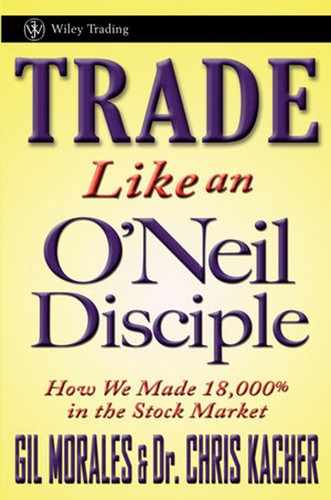Chapter 1. The Evolution of Excellence: The O'Neil Trading Method
As portfolio managers who once ran money for William J. O'Neil, we have observed that a meaningful portion of the O'Neil "body of thought" is derived from the philosophies of those who preceded him, particularly the works of Richard Wyckoff and Jesse Livermore. When it comes to market thought, you can never entirely understand Bill O'Neil until you have read and understood these two gentlemen. Obviously, the techniques and philosophies of the famous trader Jesse Livermore, as presented in the classic Reminiscences of a Stock Operator, by Edwin Lefèvre and Livermore's own How to Trade in Stocks, figure heavily in the underlying pulse that governs the way Bill O'Neil and his stable of portfolio managers trade. Richard Wyckoff, as one of the first to write about Jesse Livermore in his original work, Jesse Livermore's Methods of Trading Stocks, espoused much of the common sense investment philosophies and maxims that have found their way into the writings and investment thought of William J. O'Neil. Even Nicolas Darvas, in his famous book, How I Made $2 Million in the Stock Market (Carol Publishing Group, 1998), laid the foundation for O'Neil's "chart bases" with his own "boxes," which he described as simply normal consolidation channels within which a stock's action was judged to be normal or abnormal.
The themes that echo from Wyckoff, Livermore, Darvas, and others weave the essential fabric from which "O'Neil–style" investment methodologies are cut. These methodologies utilized the work of O'Neil's predecessors by bringing into play the time-tested characteristics of winning stocks that O'Neil painstakingly identified, analyzed, catalogued, and verified in his numerous Model Book Studies, some of which your authors had the privilege of producing and contributing to. By sifting through the best-performing, institutional-quality leading stocks in each and every type of market cycle, O'Neil identified their key common characteristics, the most basic of which provided the genesis for O'Neil's unique stock-selection template, commonly known to the investing public as CAN SLIM. Certainly, O'Neil owes a debt to the thinking of Livermore, Wyckoff, and others, and the roots of the O'Neil investment methodologies run deep in this regard. However, as former portfolio managers for William O'Neil + Company, Inc., we can vouch for the fact that such roots do not imply that O'Neil simply copied his predecessors. That would be a gross oversimplification, since the truth is that the O'Neil methodologies took the thinking of these outstanding stock market investors from the past to a much higher level by bringing greater clarity to the process as he formulated a concrete, concise, and practical approach to making money in the stock market.
The parallels between O'Neil and his predecessors provide an overarching backdrop to a general philosophy, a certain ethos, if you will, toward the market that is more than just Livermore's, or Wyckoff's, or even O'Neil's. As O'Neil himself used to tell us, "It's not MY system. It's the market's, because it is based on how the market actually works." In this manner, O'Neil simply sees his own work as furthering the basic process of understanding the market through observation and the application of common sense rules gained thereby. It is nothing more or less than understanding all the small realities that make up the stock market. Reviewing how O'Neil has taken and expanded upon the works of his predecessors is a useful exercise, and sets the backdrop for much of the research we have done to further our approach to the O'Neil/Livermore/Wyckoff approach to the market, and which is one of the main topics of this book.
